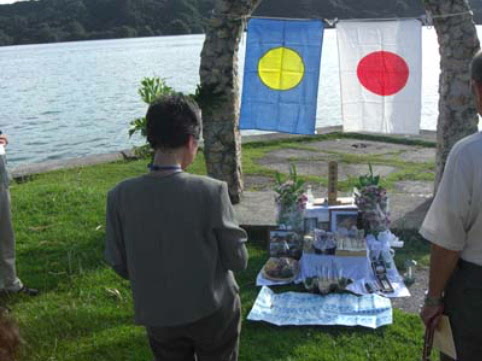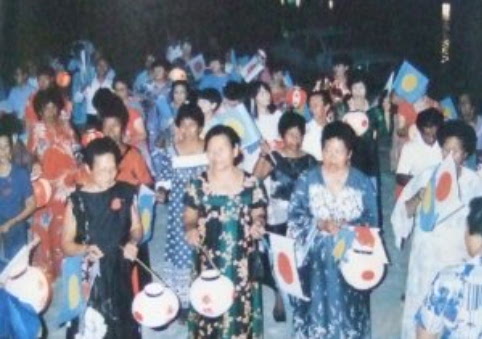Collapse of the former KB Bridge
The original Koror-Babeldaob Bridge was a balanced cantilever prestressed concrete box girder bridge with a main span of 240.8 m and total length of 385.6 m (1265 ft). It was designed by Dyckerhoff & Widmann AG and built by Socio Construction in 1977.[1] It was the worldВҘ“s largest bridge of its type, until its record was broken by the 260 m span of the Gateway Bridge in Brisbane, Australia, finished in 1985.
On September 26, 1996, the bridge suddenly collapsed and shut off fresh water and electricity between the islands. In addition, the collapse killed two people and injured four more. This caused the government to declare a state of emergency. By request of Kuniwo Nakamura, then the countryВҘ“s President and foreign minister, Japan provided emergency aid as well as a temporary bridge.
Reason for the collapse
The 18-year old, Koror-Babeldaob bridge (KB bridge) collapsed abruptly and catastrophically. The failure occurred during benign weather and loading conditions, less than three years after two independent teams of bridge engineers had evaluated the bridge and declared it safe, and less than three months after completion of a strengthening programme to correct a significant midspan sag that was continuing to worsen.
By 1990, a physical phenomenon called creep had caused the midline of the bridge to sag 1.2 meters, causing discomfort to drivers and concern for officials. The Palau government comissioned two studies by Louis Berger International and Japan International Co-operation Agency. They both concluded that the bridge was structurally safe though 1m more of creep would occur in the future. Based on the studies, the Palau government decided to counteract the cosmetic damage caused by creep with resurfacing and reinforcement of the brige.
According to British civil engineers Chris Burgoyne and Richard Scantlebury, the reinforcement operation had 4 main components.
The bridge midspan was modified, changing the originally non-weight-bearing hinged joint to a continuous block of concrete.
Eight prestress cables were added to straighten the span.
Eight flat-jacks were added to the center of the structure to add additional prestress, loading the center of the bridge.
The bridge was resurfaced to smooth out the sagging road.
The most probable progression of the collapse began with a weakening of the Babeldaob side. This caused a shear failure, resulting in all of the weight of the continuous main span coming to rest on the Koror side. This unbalanced moment caused the backspan of the Koror side to fail and tipped the bridge into the channel. The new design of the bridge hastened the bridgeВҘ“s collapse, but did not actually cause the fatal weakening of the Babeldoab flange. The ultimate cause of collapse remains unknown. [5] The repair and resurfacing operation may have contributed to the bridge failure, but since the lawsuit over the collapse was settled out of court, no final cause has ever been definitively published.
гӮӨгӮ®гғӘгӮ№дәәжҠҖеё«гҒҢгҖҢе·ҘдәӢгҒҜеҹәжң¬гҒҢеҮәжқҘгҒҰз„ЎгҒҸгҖҒиЈңеј·е·ҘдәӢгҒҢеҝ…иҰҒгҖҚгҒЁиҝ°гҒ№гҒҹгҒЁжӣёгҒӢгӮҢгҒҰгҒ„гӮӢгҖӮ
йҹ“еӣҪгҒ®дјҡзӨҫгҒҢж–Ҫе·ҘгҒ—гҒҹгҒЁжҳҺиЁҳгҒ•гӮҢгҒҰгҒ„гӮӢгҖӮ
гӮӮгҒҶдёҖеәҰгҖҒзўәиӘҚгҒ—гӮҲгҒҶгҖӮ
ж—Ҙжң¬гҒ®иіҮж–ҷгҒ гҖӮ
1977е№ҙгҒ«гӮўгғЎгғӘгӮ«гҒ®жҸҙеҠ©гӮ’еҸ—гҒ‘гҒҰгҖҒ
йҹ“еӣҪиіҮжң¬гҒ®е»әиЁӯдјҡзӨҫ ВҘ“Socio ConstructionВҘ” гҒ«гӮҲгӮҠе»әиЁӯгҒ•гӮҢгҒҹгӮігғігӮҜгғӘгғјгғҲж©ӢгҖӮеҪ“жҷӮгҒ® ВҘ“Socio ConstructionВҘ” гҒҜе®ҹиіӘзҡ„гҒ«жҠ•иіҮдјҡзӨҫгҒ§гҒӮгҒЈгҒҹгҒҹгӮҒгҖҒ
иЁӯиЁҲгҒҜгӮўгғЎгғӘгӮ«гҒ® ВҘ“Alfred A. Yee and AssociatesВҘ” гҒЁ
гғүгӮӨгғ„гҒ®е»әиЁӯдјҡзӨҫгҒ§гҒӮгӮӢDyckerhoff & Widmann AGпјҲзҸҫпјҡDYWIDAGпјүгҒҢиЎҢгҒ„гҖҒ
ж–Ҫе·ҘгҒҜ ВҘ“Dyckerhoff & Widmann AGВҘ” гҒҢиЎҢгҒЈгҒҹгҖӮ
гҒ“гҒ®ж©ӢгҒ®е»әиЁӯжҘӯиҖ…йҒёе®ҡгҒ«йҡӣгҒ—гҒҰе…ҘжңӯгҒҢиЎҢгӮҸгӮҢгҖҒ
ВҘ“Socio ConstructionВҘ” гҒҢгҖҒй№ҝеі¶е»әиЁӯгҒ®еҚҠйЎҚгҒ®е…ҘжңӯдҫЎж јгӮ’жҸҗзӨәгҒ—иҗҪжңӯгҒ—гҒҹгҖӮ
гҒӘгҒҠгҒ“гҒ® ВҘ“Socio ConstructionВҘ” зӨҫгҒҜгҖҒ
1994е№ҙгҒ«еҙ©иҗҪгҒ—гҒҹйҹ“еӣҪгҒ®иҒ–ж°ҙеӨ§ж©ӢпјҲж–Ҫе·ҘгҒҜйҹ“еӣҪгҒ®жқұдәңе»әиЁӯпјү
гҒ«дҝӮгӮҸгҒЈгҒҹдјҡзӨҫгҒЁгҒ—гҒҰж—Ҙжң¬гҒ§гҒҜзҹҘгӮүгӮҢгҒҰгҒ„гӮӢгҒҢгҖҒ
ВҘ“Socio ConstructionВҘ” гҒҜйҹ“еӣҪдәәеҮәиіҮгҒ«гӮҲгӮӢгғ‘гғ©гӮӘе…ұе’ҢеӣҪгҒ®дјҡзӨҫгҒ§гҒӮгӮҠгҖҒ
гҒқгҒ®й–ўдҝӮжҖ§гҒҜдёҚжҳҺзһӯгҒ§гҒӮгӮӢгҖӮ
еҗ„еӣҪгҒ®дјҡзӨҫгҒ«гӮҲгӮӢиЈңдҝ®гҖҒиЈңеј·е·ҘдәӢгҒҢдҪ•еәҰгӮӮиЎҢгӮҸгӮҢгҒҰгҒ„гҒҹгҒҢгҖҒ
1990е№ҙгҖҒйЎ•и‘—гҒӘдёӯеӨ®йғЁгҒ®йҷҘжІЎгҒ«йҡӣгҒ—гҒҹгғ‘гғ©гӮӘж”ҝеәңгҒҜгҖҒ
ВҘ“LOUIS BERGER INTERNATIONAL INC.ВҘ” гҒЁ
еӣҪйҡӣеҚ”еҠӣж©ҹж§ӢВҘпјҲж—Ҙжң¬пјүгҒӢгӮүжҙҫйҒЈгҒ•гӮҢгҒҹгғҒгғјгғ гҒ«гӮҲгӮӢе®үе…ЁгғҶгӮ№гғҲгӮ’иЎҢгҒ„гҖҒ
гҖҢе»әиЁӯеҪ“жҷӮдёҰгҒігҒ«зҸҫзҠ¶гҒ§гҒҜе®үе…ЁгҒ§гҒӮгӮӢгҒҢгҖҒгҒ“гҒ®гҒҫгҒҫгҒ§гҒҜйҷҘжІЎгҒҢйҖІиЎҢгҒҷгӮӢгҖҚ
гҒЁгҒ„гҒҶзөҗжһңгҒҢеҮәгҒҹгҒҹгӮҒгҖҒиЈңеј·е·ҘдәӢгӮ’йҒёжҠһгҒ—гҒҹгҖӮ
1996е№ҙ9жңҲ26ж—ҘгҒ«зӘҒ然дёӯеӨ®йғЁгҒӢгӮүзңҹгҒЈдәҢгҒӨгҒ«жҠҳгӮҢгҒҰеҙ©еЈҠгҒ—гҖҒ
2 еҗҚгҒҢжӯ»дәЎгҖҒ4 еҗҚд»ҘдёҠгҒҢжҖӘжҲ‘гӮ’иІ гҒЈгҒҹгҖӮ
ж©ӢгҒҜгӮігғӯгғјгғ«еі¶гҒӢгӮүз©әжёҜгҒёгҒЁеҗ‘гҒӢгҒҶе”ҜдёҖгҒ®йҒ“и·ҜгҒ§гҒӮгӮҠгҖҒ
гҒҫгҒҹгҖҒгғҗгғҷгғ«гғҖгӮӘгғ–еі¶гҒӢгӮүгӮігғӯгғјгғ«гҒёдҫӣзөҰгҒ•гӮҢгҒҰгҒ„гҒҹ
йӣ»ж°—гҖҒж°ҙйҒ“гҒӘгҒ©гҒ®гғ©гӮӨгғ•гғ©гӮӨгғігҒҢйҖҡгҒЈгҒҰгҒ„гҒҹгҒҹгӮҒгҖҒ
дёҖжҷӮгҒҜеӣҪ家йқһеёёдәӢж…Ӣе®ЈиЁҖгҒҢеҮәгҒ•гӮҢгҒҹгҖӮ
гҒ“гҒ®ж©ӢгҒ«гҒӨгҒ„гҒҰгҒҜгҖҢжүӢжҠңгҒҚе·ҘдәӢгҒ§гҒҜгҒӘгҒ„гҒӢ?гҖҚгҒЁгҒ„гҒҶжҢҮж‘ҳгӮӮгҒӮгӮҠгҖҒ
ж—§ KB гғ–гғӘгғғгӮёгҒҜгғҸгғігӮ°гғ«гҒЁгӮўгғ«гғ•гӮЎгғҷгғғгғҲгҒ®зў‘ж–ҮгҒҢеҲ»гҒҫгӮҢгҒҹ
иЁҳеҝөзў‘гҒ®гҒҝгҒҢж®ӢгҒ•гӮҢгҒҰгҒ„гӮӢгҒҢгҖҒ
дҪ•иҖ…гҒӢгҒ«гӮҲгӮҠ ВҘ“KOREAВҘ” гҒ®ж–Үеӯ—гҒҢеүҠгӮүгӮҢгҒҰгҒ„гӮӢгҖӮ
ж–°KBгғ–гғӘгғғгӮё
2002е№ҙ1жңҲгҖҒж—Ҙжң¬гҒ®ж”ҝеәңй–ӢзҷәжҸҙеҠ© (ODA) гҒ«гӮҲгҒЈгҒҰеҶҚе»әгҒ•гӮҢгҒҹж©ӢгҖӮ
жӯЈејҸеҗҚз§°гҒҜгҖҢж—Ҙжң¬ - гғ‘гғ©гӮӘиҰӘе–„гҒ®ж©ӢпјҲйҖҡз§°пјҡж—ҘеёӣеҸӢеҘҪж©ӢпјүгҖҚгҒЁгҒ„гҒҶгҖҒ
пјҲJapan - Palau Friendship BridgeпјүгҖӮ
ж—§KBгғ–гғӘгғғгӮёеҙ©иҗҪгӮ’еҸ—гҒ‘гҖҒеҗ„еӣҪгҒҜж”ҜжҸҙгӮ’й–Ӣе§ӢгҒ—гҒҹгҖӮ
ж—Ҙжң¬гӮӮйЈІж–ҷж°ҙгҒ®з·ҠжҖҘијёйҖҒгӮ„д»®иЁӯж©Ӣ
пјҲpontoon bridgeгҒЁе‘јгҒ°гӮҢгӮӢгғ—гғ¬гғјгғҲгӮ’гҒӨгҒӘгҒ„гҒ§дҪңгӮӢжө®гҒҚж©Ӣпјү
гҒ®иЁӯзҪ®гҒӘгҒ©гҒ®ж”ҜжҸҙгӮ’иЎҢгҒЈгҒҰгҒ„гҒҹгҖӮ
гғ‘гғ©гӮӘж”ҝеәңгҒҢиІЎж”ҝзҡ„гҒӘзҗҶз”ұгҒӢгӮүиҮӘеӣҪгҒ®иіҮйҮ‘гҒ«гӮҲгӮӢе»әиЁӯгӮ’ж–ӯеҝөгҒ—гҒҹгҒҹгӮҒгҖҒ
1997е№ҙгҒ«з„Ўе„ҹжҸҙеҠ©гҒ«гӮҲгӮӢж©ӢгҒ®еҶҚе»әгӮ’жұәе®ҡгҒ—й№ҝеі¶е»әиЁӯгҒ«гӮҲгҒЈгҒҰеҶҚе»әгҒ•гӮҢгҒҹгҖӮ
5е№ҙеҫҢгҒ®2002е№ҙ1жңҲгҒ«ж©ӢгҒҜе®ҢжҲҗгҒ—гҖҒ1жңҲ11ж—ҘгҒ«гҒҜй–ӢйҖҡејҸе…ёгҒҢиЎҢгӮҸгӮҢгҒҹгҖӮ
гҒ“гҒ®ж–°гҒ—гҒ„ж©ӢгҒ®гҒҹгӮӮгҒЁгҒ®иЁҳеҝөзў‘гҒ«гҒҜгҖҒ
ж—Ҙжң¬-гғ‘гғ©гӮӘиҰӘе–„гҒ®ж©Ӣ (Japan - Palau Friendship Bridge) гҒЁеҲ»гҒҫгӮҢгҖҒ
дёЎеӣҪгҒ®еӣҪж——гҒҢжҸҸгҒӢгӮҢгҒҰгҒ„гӮӢгҖӮ
дё–з•ҢгҒ§гӮӮгҖҒпј‘пјҢпј’гӮ’дәүгҒҶиҰӘж—ҘеӣҪ家гғ‘гғ©гӮӘгҖӮ
Collapse of the former KB Bridge
The original Koror-Babeldaob Bridge was a balanced cantilever prestressed concrete box girder bridge with a main span of 240.8 m and total length of 385.6 m (1265 ft). It was designed by Dyckerhoff & Widmann AG and built by Socio Construction in 1977.[1] It was the world"s largest bridge of its type, until its record was broken by the 260 m span of the Gateway Bridge in Brisbane, Australia, finished in 1985.
On September 26, 1996, the bridge suddenly collapsed and shut off fresh water and electricity between the islands. In addition, the collapse killed two people and injured four more. This caused the government to declare a state of emergency. By request of Kuniwo Nakamura, then the country"s President and foreign minister, Japan provided emergency aid as well as a temporary bridge.
Reason for the collapse
The 18-year old, Koror-Babeldaob bridge (KB bridge) collapsed abruptly and catastrophically. The failure occurred during benign weather and loading conditions, less than three years after two independent teams of bridge engineers had evaluated the bridge and declared it safe, and less than three months after completion of a strengthening programme to correct a significant midspan sag that was continuing to worsen.
By 1990, a physical phenomenon called creep had caused the midline of the bridge to sag 1.2 meters, causing discomfort to drivers and concern for officials. The Palau government comissioned two studies by Louis Berger International and Japan International Co-operation Agency. They both concluded that the bridge was structurally safe though 1m more of creep would occur in the future. Based on the studies, the Palau government decided to counteract the cosmetic damage caused by creep with resurfacing and reinforcement of the brige.
According to British civil engineers Chris Burgoyne and Richard Scantlebury, the reinforcement operation had 4 main components.
The bridge midspan was modified, changing the originally non-weight-bearing hinged joint to a continuous block of concrete.
Eight prestress cables were added to straighten the span.
Eight flat-jacks were added to the center of the structure to add additional prestress, loading the center of the bridge.
The bridge was resurfaced to smooth out the sagging road.
The most probable progression of the collapse began with a weakening of the Babeldaob side. This caused a shear failure, resulting in all of the weight of the continuous main span coming to rest on the Koror side. This unbalanced moment caused the backspan of the Koror side to fail and tipped the bridge into the channel. The new design of the bridge hastened the bridge"s collapse, but did not actually cause the fatal weakening of the Babeldoab flange. The ultimate cause of collapse remains unknown. [5] The repair and resurfacing operation may have contributed to the bridge failure, but since the lawsuit over the collapse was settled out of court, no final cause has ever been definitively published.
мҳҒкөӯмқё кё°мӮ¬к°Җ гҖҢкіөмӮ¬лҠ” кё°ліёмқҙ лҗҳм–ҙмһҲм§Җ м•Ҡкі , ліҙк°• кіөмӮ¬к°Җ н•„мҡ”гҖҚлқјкі л§җн–ҲлӢӨкі м“°м—¬м ё мһҲлӢӨ.
н•ңкөӯмқҳ нҡҢмӮ¬к°Җ мӢңкіөн–ҲлӢӨкі лӘ…кё°лҗҳм–ҙ мһҲлӢӨ.
н•ңлІҲ лҚ”, нҷ•мқён•ҳмһҗ.
мқјліёмқҳ мһҗлЈҢлӢӨ.
1977л…„м—җ лҜёкөӯмқҳ мӣҗмЎ°лҘј л°ӣкі ,
н•ңкөӯ мһҗліёмқҳ кұҙм„ӨнҡҢмӮ¬ "Socio Construction" м—җ мқҳн•ҙ кұҙм„Өлҗң мҪҳнҒ¬лҰ¬нҠёлӢӨлҰ¬.лӢ№мӢңмқҳ "Socio Construction" лҠ” мӢӨм§Ҳм ҒмңјлЎң нҲ¬мһҗ нҡҢмӮ¬мҳҖкё° л•Ңл¬ём—җ,
м„Өкі„лҠ” лҜёкөӯмқҳ "Alfred A. Yee and Associates" мҷҖ
лҸ…мқјмқҳ кұҙм„ӨнҡҢмӮ¬мқё Dyckerhoff & Widmann AG(нҳ„пјҡDYWIDAG)к°Җ мӢӨмӢңн•ҙ,
мӢңкіөмқҖ "Dyckerhoff & Widmann AG" к°Җ к°”лӢӨ.
мқҙ лӢӨлҰ¬мқҳ кұҙм„Өм—…мһҗ м„ м •м—җ мһ„н•ҳм—¬ мһ…м°°мқ„ н•ҙ
"Socio Construction" к°Җ, м№ҙмӢңл§Ҳ кұҙм„Өмқҳ л°ҳм•Ўмқҳ мһ…м°° к°ҖкІ©мқ„ м ңмӢңн•ҙ лӮҷм°°н–ҲлӢӨ.
лҚ” мқҙ "Socio Construction" мӮ¬лҠ”,
1994л…„м—җ нҸӯлқҪн•ң н•ңкөӯмқҳ м„ұмҲҳ мҳӨмҳӨн•ҳмӢң(мӢңкіөмқҖ н•ңкөӯмқҳ лҸ„мҡ°м•„кұҙм„Ө)
(мҷҖ)кіј кҙҖкі„лҗң нҡҢмӮ¬лЎңм„ң мқјліём—җм„ңлҠ” м•Ңл Өм ё мһҲм§Җл§Ң,
"Socio Construction" лҠ” н•ңкөӯмқё м¶ңмһҗм—җ мқҳн•ң нҢ”лқјмҡ° кіөнҷ”көӯмқҳ нҡҢмӮ¬мқҙл©°,
к·ё кҙҖкі„м„ұмқҖ л¶ҲлӘ…лЈҢн•ҳлӢӨ.
к°Ғкөӯмқҳ нҡҢмӮ¬м—җ мқҳн•ң ліҙмҲҳ, ліҙк°• кіөмӮ¬к°Җ лӘҮлІҲмқҙлӮҳ н–үн•ҙм§Җкі мһҲм—Ҳм§Җл§Ң,
1990л…„, нҳ„м Җн•ң мӨ‘м•ҷл¶Җмқҳ н•ЁлӘ°м—җ мҰҲмқҢн•ң нҢ”лқјмҡ° м •л¶ҖлҠ”,
"LOUIS BERGER INTERNATIONAL INC." (мҷҖ)кіј
көӯм ң нҳ‘л Ҙ кё°кө¬(мқјліё)лЎңл¶Җн„° нҢҢкІ¬лҗң нҢҖм—җ мқҳн•ң м•Ҳм „ н…ҢмҠӨнҠёлҘј мӢӨмӢңн•ҙ,
гҖҢкұҙм„Ө лӢ№мӢң л°Ҹ нҳ„мһ¬ мғҒнғңлЎңм„ңлҠ” м•Ҳм „н•ҳм§Җл§Ң, мқҙлҢҖлЎңлҠ” н•ЁлӘ°мқҙ 진н–үн•ңлӢӨгҖҚ
к·ёл ҮлӢӨкі н•ҳлҠ” кІ°кіјк°Җ лӮҳмҷ”кё° л•Ңл¬ём—җ, ліҙк°• кіөмӮ¬лҘј м„ нғқн–ҲлӢӨ.
1996л…„ 9мӣ” 26мқјм—җ лҸҢм—° мӨ‘м•ҷл¶ҖлЎңл¶Җн„° л‘җлҸҷк°•мқҙм—җ м ‘нҳҖ 붕кҙҙн•ҙ,
2 лӘ…мқҙ мӮ¬л§қ, 4 лӘ… мқҙмғҒмқҙ мғҒмІҳлҘј мһ…м—ҲлӢӨ.
лӢӨлҰ¬лҠ” мҪ”лЎңлҘҙ섬м—җм„ң кіөн•ӯмңјлЎң н–Ҙн•ҳлҠ” мң мқјн•ң лҸ„лЎңмқҙл©°,
лҳҗ, л°”лІ лҘҙлӢӨмҳӨлёҢ섬мңјлЎңл¶Җн„° мҪ”лЎңлҘҙм—җ кіөкёүлҗҳкі мһҲм—ҲлӢӨ
м „кё°, мҲҳлҸ„л“ұмқҳ лқјмқҙн”„лқјмқёмқҙ лӢӨлӢҲкі мһҲм—Ҳкё° л•Ңл¬ём—җ,
н•ңл•ҢлҠ” көӯк°Җ 비мғҒмӮ¬нғң м„ м–ёмқҙ лӮҳмҷ”лӢӨ.
мқҙ лӢӨлҰ¬м—җ лҢҖн•ҙм„ңлҠ” гҖҢл¶ҖмӢӨ кіөмӮ¬к°Җ м•„лӢҢк°Җ?гҖҚлқјкі н•ҳлҠ” м§Җм ҒлҸ„ мһҲм–ҙ,
кө¬ KB лёҢлҰҝм§ҖлҠ” н•ңкёҖкіј м•ҢнҢҢлІімқҳ 비문мқҙ мғҲкІЁмЎҢлӢӨ
кё°л…җ비л§Ңмқҙ лӮЁм•„ мһҲм§Җл§Ң,
лҲ„кө°к°Җм—җ мқҳн•ҙ "KOREA" мқҳ л¬ёмһҗк°Җ к№Һм•„м§Җкі мһҲлӢӨ.
мӢ KBлёҢлҰҝм§Җ
2002л…„ 1мӣ”, мқјліёмқҳ м •л¶Җк°ңл°ңмӣҗмЎ° (ODA)м—җ мқҳн•ҙм„ң мһ¬кұҙлҗң лӢӨлҰ¬.
м •мӢқлӘ…м№ӯмқҖ гҖҢмқјліё - нҢ”лқјмҡ° м№ңм„ мқҳ лӢӨлҰ¬(нҶөм№ӯпјҡмқј л°ұмҡ°нҳёлӢӨлҰ¬)гҖҚлқјкі н•ҳлҠ”,
(Japan - Palau Friendship Bridge).
кө¬KBлёҢлҰҝм§Җ нҸӯлқҪмқ„ л°ӣм•„ к°ҒкөӯмқҖ м§Җмӣҗмқ„ к°ңмӢңн–ҲлӢӨ.
мқјліёлҸ„ мқҢлЈҢмҲҳмқҳ кёҙкёү мҲҳмҶЎмқҙлӮҳ к°Җм„ӨлӢӨлҰ¬
(pontoon bridgeлЎң л¶ҲлҰ¬лҠ” н”Ңл ҲмқҙнҠёлҘј мқҙм–ҙ л§Ңл“ңлҠ” л¶Җкөҗ)
мқҳ м„Өм№ҳл“ұмқҳ м§Җмӣҗмқ„ мӢӨмӢңн•ҳкі мһҲм—ҲлӢӨ.
нҢ”лқјмҡ° м •л¶Җк°Җ мһ¬м •м Ғмқё мқҙмң лЎңл¶Җн„° мһҗкөӯмқҳ мһҗкёҲм—җ мқҳн•ң кұҙм„Өмқ„ лӢЁл…җн–Ҳкё° л•Ңл¬ём—җ,
1997л…„м—җ л¬ҙмғҒ мӣҗмЎ°м—җ мқҳн•ң лӢӨлҰ¬мқҳ мһ¬кұҙмқ„ кІ°м •н•ҙ м№ҙмӢңл§Ҳ кұҙм„Өм—җ мқҳн•ҙм„ң мһ¬кұҙлҗҳм—ҲлӢӨ.
5л…„ нӣ„мқҳ 2002л…„ 1мӣ”м—җ лӢӨлҰ¬лҠ” мҷ„м„ұн•ҙ, 1мӣ” 11мқјм—җлҠ” к°ңнҶөмӢқм „мқ„ н–ҲлӢӨ.
мқҙ мғҲлЎңмҡҙ лӢӨлҰ¬мқҳ мҶҢл§Өмқҳ кё°л…җ비м—җлҠ”,
мқјліё-нҢ”лқјмҡ° м№ңм„ мқҳ лӢӨлҰ¬ (Japan - Palau Friendship Bridge)мҷҖ мғҲкІЁм ё
м–‘көӯмқҳ көӯкё°к°Җ к·ёл Өм ё мһҲлӢӨ.


м„ёкі„м—җм„ңлҸ„, 1, 2лҘј мӢёмҡ°лҠ” м№ңмқј көӯк°Җ нҢ”лқјмҡ°.
������������������

